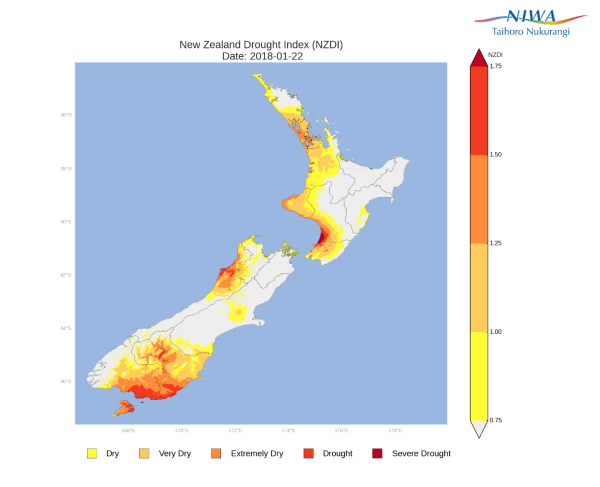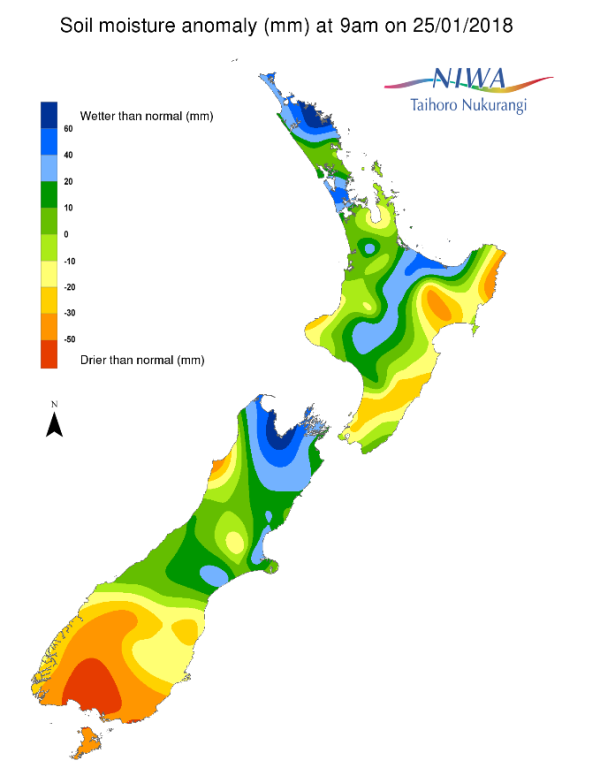A weekly update describing soil moisture across the country to help assess whether severely to extremely dry conditions are occurring or imminent. Regions experiencing these soil moisture deficits are deemed “hotspots”. Persistent hotspot regions have the potential to develop into drought.
Facts: Soil Moisture
Across the North Island, soil moisture levels generally saw only minor changes during the past week. The largest increases were observed across Auckland, the Far North, and northern Waikato. Meanwhile, soil moisture decreases were observed across much of the east coast, particularly in coastal Gisborne, with smaller decreases in parts of Hawke’s Bay and Wairarapa. The driest soils compared to normal for this time of the year are found in coastal Gisborne and interior Wairoa, while the wettest soils for this time of the year are located in the eastern Far North District.
Current North Island hotspots are found in coastal Gisborne, interior Wairoa, as well as small portions of Kapiti Coast, Horowhenua, and Tararua.
Across the South Island, soil moisture levels generally decreased slightly in northern and central areas during the past week, while the lower South Island saw little change. The driest soils compared to normal for this time of the year continue to be found in southern Southland, while the wettest soils for this time of the year are centred around Nelson.
The only hotspot in the South Island continues to be a sizeable one which covers much of southern and interior Otago and nearly all of Southland.
The New Zealand Drought Index (NZDI) shows continued improvement in meteorological drought conditions across the lower North Island and Buller District. However, meteorological drought continues to emerge and strengthen across interior and southern Otago and southern Southland.
Outlook and Soil Moisture
In the North Island, high pressure will prevent widespread significant rainfall for the majority of the next week. However, nearly each afternoon there will be the chance for isolated pop-up showers and thunderstorms due to warm temperatures and atmospheric instability. Therefore, while most locations across the North Island will likely see total rainfall amounts of less than 15 mm through Wednesday (31st January), a few places that see heavier downpours could receive more than 30 mm. By next Thursday there is the possibility that a front associated with an ex-tropical cyclone in the Tasman Sea could bring moderate or even heavy rainfall to western and central parts of the North Island. There remains uncertainty about the timing and strength of this event, but should it occur, amounts greater than 25 mm will be possible.
With most locations seeing only spotty showers and thunderstorms over the next several days, minor decreases in soil moisture levels are expected across the North Island. This may be reversed, however, if the moisture-rich front arrives by next Thursday (1st February). Still, an increase in the size and strength of the hotspots along the east coast is most likely during the next week.
In the South Island, dominant high pressure will prevent substantial precipitation over the next several days, with most locations receiving less than 10 mm through Tuesday (30th January). However, by Wednesday and Thursday there is the possibility for a front to combine with an ex-tropical cyclone in the Tasman Sea to bring heavy rainfall to much of the South Island.
Should next week’s heavy rainfall occur, substantial increases in soil moisture levels would be expected, although flooding would also be a possibility in places where dry soils lead to increased runoff. However, heavy rainfall would also substantially weaken the longstanding hotspot in the lower South Island.
Background:
Hotspot Watch: a weekly advisory service for New Zealand media. It provides soil moisture and precipitation measurements around the country to help assess whether extremely dry conditions are imminent.
Soil moisture deficit: the amount of water needed to bring the soil moisture content back to field capacity, which is the maximum amount of water the soil can hold.
Soil moisture anomaly: the difference between the historical normal soil moisture deficit (or surplus) for a given time of year and actual soil moisture deficits.
Definitions: “Extremely” and “severely” dry soils are based on a combination of the current soil moisture status and the difference from normal soil moisture (see soil moisture maps)



